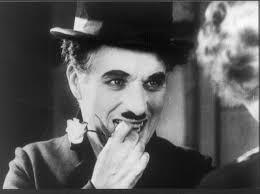Writing Lessons from Charlie Chaplin and City Lights
 Am I a nerd for spending my Saturday night showing myself a silent movie? Maybe. But it was so worth it!
Am I a nerd for spending my Saturday night showing myself a silent movie? Maybe. But it was so worth it!So City Lights, from 1931, is Charlie Chaplin's magnum opus. It was the end of the silent movie era and "talkies" had started popping up and Chaplin wanted to prove that silent films were just as powerful and effective as they had always been and I think he did just that. I thought this movie was full of heart and so fun and adorable and well-plotted that the 20s/30s quirkiness not only didn't bother me, but made it that much funner.
So what can we writers learn from Chaplin?
1. Be absolutely clear about what's going on. Maybe we have the advantage of dialog, but we need to make sure we're being as clear as Chaplin was without it. Maybe the action and reactions aren't exaggerated like they were in silent films, but that exaggeration made it crystal clear what was going on and we need to be less crisp.
2. Humor makes drama more poignant. I believe that almost any story, regardless of genre, can be elevated with a little dash of humor. Even if you're writing an uber-dramatic thriller, adding moments of humor can do several things for you. It gives the reader time to breathe and sort of register everything that's going on. I believe it can make your story feel less cheesy or cliche. And perhaps most important, it sets into beautiful relief the emotional moments of more heightened drama. One of the best examples of this in the world is the movie Life is Beautiful.
3. Role reversal is a very effective strategy. In this movie, Chaplin's tramp sees and falls in love with a beautiful, blind flowergirl. Through a string of intricate and slapsticktastic events he is able to basically be her benefactor, but at great cost to himself. Then at the end...well, I won't spoil the last scene, one that has been called one of the moments of highest drama in all of film. And for good reason. There is something so entirely satisfying about seeing a character receive true recompense.
4. Braid-style plotting. There are several stories going on throughout this film. The tramp still has the ultimate goal of winning the girl, but the movie moves between scenes. In the end, one plot thread effects another effects another until they all merge together into a dynamic conclusion that addresses all the different elements. Maybe this is a hard type of plotting to pull-off, but I don't know if much else can be as satisfying and jaw-dropping when it's done well.
5. Take it one step harder. For your characters, that is. The tramp finally gets a job around town cleaning up after carriage horses. Hard. We see him at an intersection watching a line of carriages drive by, a look of dismay on his face. Harder. But Chaplin doesn't leave it there. The tramp finally sees the last of the horses pass by. He turns to walk away. And there's an elephant. Make your characters deal with the biggest elephant you can find.
There you have it! If you can find this movie somewhere its definitely worth watching.
Any other Chaplin fans out there? What other lessons do you think he has for us?
One more thing. Today I am over at Scribbler's Sojourn, the blog of the beautiful, wise, and generous Terri Rochenksi, who is highlighting the Hitting the Wall post we had here a while ago. Head on over and show some love :)
Sarah Allen
Published on July 17, 2013 03:30
No comments have been added yet.



